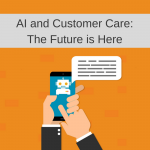The WFM Formula for Managing AI Escalations

AI Can Handle Everything… Until It Can’t
We’ve spent a lot of time thinking—and talking—about AI’s role in transforming the customer experience. From instant answers to always-on support, automation has opened the door to faster, smarter service.
But what happens when AI can’t solve the problem?
When a customer needs to escalate to a human, everything changes. The expectations are different. The stakes are higher. If that moment is mishandled—if the customer must repeat themselves, wait too long, or is met with someone not empowered to help—it doesn’t just damage satisfaction. It erodes trust. Worse, it makes the entire AI experience feel like smoke and mirrors.
That’s when it becomes clear that escalation readiness is more than a CX issue, it’s a brand reputation issue. And the challenge goes deeper than technology. It’s about whether your staffing model is prepared for the edge case. Ultimately, your ability to deliver in that moment depends entirely on one thing: workforce management.
Are you staffed, trained, and ready for the moment when AI hands off to your humans?
AI Doesn’t Eliminate People—It Repositions Them
AI excels at deflecting simple contacts: password resets, tracking updates, appointment confirmations. It streamlines what used to flood your contact center queue.
But escalations? They don’t follow the rules.
- They’re unpredictable.
- They spike at strange times.
- They demand skill, nuance, and empathy.
- And they need to be handled right now.
Imagine a customer who’s already tried self-service twice—maybe they’ve rebooked a flight, changed their address, or canceled an order. Now they’ve hit a billing issue the chatbot can’t resolve. This isn’t a “please hold” moment. It’s a high-emotion, high-context interaction that demands speed, clarity, and ownership. It’s the opposite of transactional.
The smoother your AI experience, the higher the expectation for what happens when it fails. If the digital path suddenly dead-ends in a 10-minute queue to speak with a human, you’ve undone the very efficiency you built.
And that is where you discover the operational paradox: automation scales effortlessly—until it doesn’t. When AI is handling the bulk of contacts, it’s tempting to assume fewer humans are needed to support the contact center. But since escalations don’t follow predictable curves or queue up politely, you can’t have one person sitting around waiting to catch every complex, high-stakes interaction while a thousand AI conversations run in parallel. That kind of model breaks down fast, leaving agents overwhelmed and customers frustrated.
The WFM Blind Spot: Escalation-Readiness
Traditional workforce management strategies are built on forecastable patterns: volumes, peaks, handle times. But escalation volume isn’t always predictable, and the cost of getting it wrong is high.
Escalation mismanagement doesn’t just hurt experience—it creates ripple effects across operations. When teams are understaffed for the overflow, calls bounce, AHT surges, and CSAT drops. And when forecasting misses these moments entirely, it puts pressure on the next shift—or worse, on frontline leaders trying to recover in real time.
On the flip side, if you’re overstaffed and agents are idle, it drives disengagement and higher turnover.
There’s high risk for a blind spot here: how do you staff for the rare-but-critical moment, without wasting resources? This is where modern workforce management tools must evolve.
Smarter Workforce Management with AI
The irony isn’t lost on us: AI creates the escalation challenge, but it also helps solve it. Today’s advanced workforce management platforms bring real-time adaptability and predictive modeling into the equation—allowing teams to react to unexpected spikes, simulate potential disruption scenarios, and forecast more precisely where and when escalation support will be needed.
Contact center WFM teams are using AI to:
- Analyze historical escalation patterns → Look for friction points that lead to live-agent handoffs: order confusion, payment issues, failed verification.
- Reforecast in real time → Dynamically shift resources based on queue behavior and contact triggers—not just volume spikes.
- What-if simulations → Model seasonality, campaign impact, or even outage scenarios to plan escalation-ready pools in advance.
- Skill-based scheduling → Ensure not just coverage, but emotional intelligence and issue-specific expertise are built into the plan.
This isn’t “set it and forget it” automation. It’s smart, responsive workforce management designed to support customers and the humans helping them.
Don’t Bench Talent—Flex It
The answer isn’t to create an idle bench of agents “just in case” of escalations. Instead, we recommend building a flexible, cross-skilled workforce that can pivot to escalations when needed, and contribute elsewhere when not.
Here’s how to get it right:
- Cross-train escalation-ready agents to take on strategic support, QA, or coaching roles when not handling contacts
- Use AI-driven WFM tools to offer mobile notifications, shift bidding, and intraday flexibility
- Tie conversation intelligence data to WFM planning, so you know where escalations are likely to emerge, and staff accordingly
- Build agile schedules that match skill level, not just volume
Additionally, be aware that in an AI-driven model, the role of the agent changes. They’re not the first stop—they’re the final one. That makes every human interaction more complex and more valuable. These agents need better tools, deeper training, and more empowerment to resolve issues without bouncing customers around. Because when the AI taps out, your agents are stepping into the spotlight, and they need to be ready.
Escalation is the Moment of Truth. WFM is Your Safety Net.
AI has raised the bar for what customers expect: speed, accuracy, convenience. But it also introduces a new kind of pressure: what happens when AI doesn’t have the answer?
Those moments—rare but reputation-defining—are where workforce management earns its keep.
At Blue Ocean, we see workforce management not as a back-office function, but as a frontline strategy. As more contact centers embrace AI and automation, the organizations that thrive will be those that not only automate better but also escalate better. That means rethinking WFM as more than a resourcing function. It’s strategic infrastructure. It’s how you ensure the customer journey has a safety net. And it’s how you make sure every AI investment is backed by human expertise, precisely when it counts.
Looking for a customer care partner that can help you find the right balance? Our team can design a custom solution built around the right talent, smart use of AI and digital tools, and a workforce strategy that achieves your customer experience goals.




